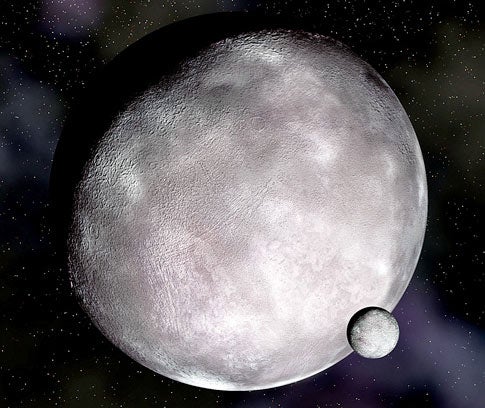Die-hard Pluto fans still seeking redemption for their demoted planet have cause for despair this week. New data show that the dwarf planet Eris is 27 percent more massive than Pluto, thereby strengthening the decree last year that there are eight planets in the solar system and a growing list of dwarf planets.
According to Mike Brown, the discoverer of Eris, and his graduate student Emily Schaller, the data confirm that Eris weighs 16.6 billion trillion kilograms. They know this because of the time it takes Eris’ moon, Dysnomia, to complete an orbit.
“This was Pluto’s last chance to be the biggest thing found so far in the Kuiper belt,” said Brown, a professor of planetary astronomy at the California Institute of Technology. “There was a possibility that Pluto and Eris were roughly the same size, but these new results show that it’s second place at best for Pluto.”
Eris was discovered in 2005 with Palomar Observatory’s 48-inch Samuel Oschin Telescope, an instrument specially adapted to do comprehensive searches for objects in the sky.
When it became apparent that Eris was similar in size if not larger than Pluto, Brown and others called for the International Astronomical Union to rule on its planetary status. The end result was demotion of Pluto and the redesignation of it and other Kuiper-belt objects as dwarf planets.
Schaller said that the new results, obtained with Hubble Space Telescope and Keck Observatory data, indicate that the density of the material making up Eris is about two grams per cubic centimeter. This means that Eris likely is made up of ice and rock, and thus is similar in composition to Pluto. Past results from the Hubble Space Telescope had already allowed planetary scientists to determine that its diameter is 2,400 kilometers, also larger than Pluto’s.
“Pluto and Eris are essentially twins — except that Eris is slightly the pudgier of the two,” Brown said. “And a little colder,” Schaller added.
The reason for Eris’ blustery surface conditions is its distance from the sun. Currently 97 astronomical units from the sun (an astronomical unit being the distance between the sun and Earth), Eris hovers at temperatures well below 400 degrees Fahrenheit and is pretty dark.
However, things get a little better on Eris now and then. Orbiting the sun on a highly elliptical 560-year journey, Eris sweeps in as close to the sun as 38 astronomical units. But at present it is nearly as far away as it ever gets.
Pluto’s own elliptical orbit takes it as far away as 50 astronomical units from the sun during its 250-year revolution. This means that Eris is sometimes much closer to Earth than Pluto, although never closer than Neptune.
Based on spectral data, the researchers think Eris is covered with a layer of methane that has seeped from the interior and frozen on the surface. As in the case of Pluto, the methane has undergone chemical transformations, probably due to the faint solar radiation, causing the methane layer to redden. But the methane surface on Eris is somewhat more yellowish than the reddish-yellow surface of Pluto, perhaps because Eris is farther from the sun.
As for Dysnomia, the tiny satellite remains the only moon discovered orbiting Eris so far. Dysnomia is about 150 kilometers in diameter, about 37,000 kilometers from Eris, and has a lunar “month” that lasts 16 days.
“But every year is 560 Earth-years,” Brown said. “So on Eris they have a lot more months in their calendar.”
Like the Earth-moon system, Eris-Dysnomia probably formed about 4.5 billion years ago following a massive collision.










